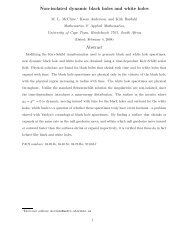Helen B. Sawyer A Bibliography of Individual Globular Clusters
Helen B. Sawyer A Bibliography of Individual Globular Clusters
Helen B. Sawyer A Bibliography of Individual Globular Clusters
Create successful ePaper yourself
Turn your PDF publications into a flip-book with our unique Google optimized e-Paper software.
A <strong>Bibliography</strong> <strong>of</strong> <strong>Globular</strong> <strong>Clusters</strong> 387<br />
kilometres a second are by Mayall, 1946; the number <strong>of</strong> variables<br />
according to <strong>Sawyer</strong>, 1939, with some more recent adjustments. The<br />
magnitudes <strong>of</strong> bright stars and variables are from the most recent<br />
reliable published observations to be found under each cluster. The<br />
color excess is by Stebbins and Whitford, 1936. The modulus from<br />
variables in the next to the last column <strong>of</strong> the table is uncorrected<br />
for absorption, and the reader may apply the correction which seems<br />
to him best to fit the case. Many <strong>of</strong> the blanks in the table will be<br />
filled during the coming months from studies <strong>of</strong> the David Dunlap<br />
plates.<br />
(a) It is interesting to note from this catalogue the distribution<br />
<strong>of</strong> globular clusters by constellation. The 99 globular clusters are<br />
found in only 37 <strong>of</strong> the constellations. Somewhat surprisingly, the<br />
largest number <strong>of</strong> globular clusters is found in the constellation <strong>of</strong><br />
Ophiuchus, which has 20. The second largest total, 17, is as one<br />
would expect, in Sagittarius; Scorpio is third with 8. Xo other<br />
constellation has more than 3. Six constellations have 3 each,<br />
7 have 2, and 22 have one. The distribution by constellation is as<br />
follows:<br />
Ophiuchus 20, Sagittarius 17, Scorpio 8, 3 each in Coma Berenices,<br />
Lupus, Hercules, Ara, Pavo, and Aquarius; 2 each in Toucan,<br />
Musca, Hydra, Centaurus, Apus, Serpens, Delphinus; one cluster<br />
each in Sculptor, Horologium, Mensa,Columba,Lepus,Puppis,Lynx,<br />
Carina, Vela, Canes Venatici, Bootes, Virgo, Libra, Norma, Corona<br />
Austrina, Telescopium, Scutum, Aquila, Lyra, Sagitta, Pegasus,<br />
Capricornus.<br />
The heaviest concentration <strong>of</strong> known globular clusters is definitely<br />
in the region <strong>of</strong> Ophiuchus-Sagittarius, rather than in the more<br />
commonly mentioned one <strong>of</strong> Sagittarius-Scorpio.<br />
(b) A feature <strong>of</strong> the main section <strong>of</strong> the bibliography is that for<br />
each cluster I have tried to indicate the date <strong>of</strong> the first recorded<br />
observation. This is the first observation <strong>of</strong> the object in the sky;<br />
I have not attempted to indicate when the object was first correct ly<br />
assigned to the globular category. Even at the present day the<br />
proper classification <strong>of</strong> some objects is still doubtful.<br />
It is interesting then to note the astronomers who first observed<br />
these objects in the sky. The man who leads all others in the<br />
discovery <strong>of</strong> globular clusters is Sir William Herschel, who found<br />
exactly one-third <strong>of</strong> the clusters accepted as globular today.





